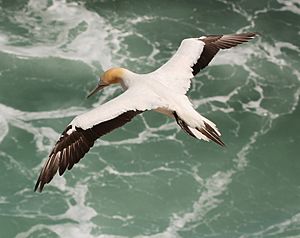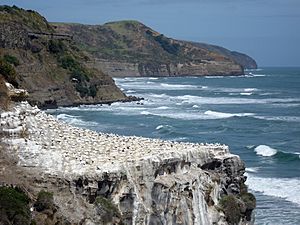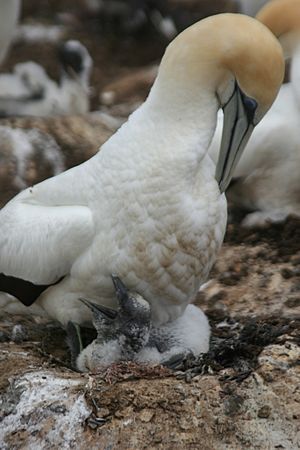Australasian gannet facts for kids
Quick facts for kids Australasian gannet |
|
|---|---|
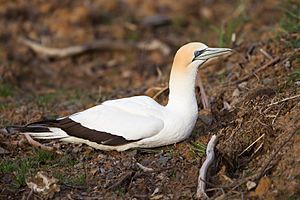 |
|
| Conservation status | |
| Scientific classification | |
| Genus: |
Morus (bird)
|
| Species: |
serrator
|
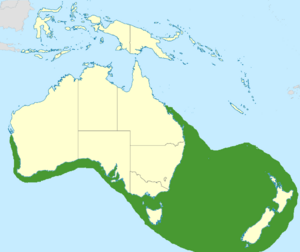 |
|
| Australasian gannet range | |
| Synonyms | |
|
Sula australis Gould, 1841 |
|
The Australasian gannet (Morus serrator), also called the Australian gannet or tākapu, is a large seabird. It belongs to the booby and gannet family, called Sulidae. Adult gannets are mostly white. They have black flight feathers on their wingtips and along the back edge of their wings. Their central tail feathers are also black. Their heads are a yellowish-buff color, with a pale blue-grey beak outlined in black. Their eyes have blue rings around them.
Young gannets look different. In their first year, they have spotted feathers that are dark on top and light underneath. Their heads are a mottled grey, and their beaks are dark. They slowly get more white feathers over several years. They become fully grown adults after about five years.
These birds live in the ocean near the coasts of southern and eastern Australia. They are found from Western Australia to Queensland. They also live around the North and South Islands of New Zealand, and on Lord Howe and Norfolk Islands. They build their nests in large groups called colonies along the coasts of New Zealand, Victoria, and Tasmania. Most colonies are on islands, but some are on the mainland.
Australasian gannets are very protective of their nests during breeding season. They perform special displays to defend their space. Pairs of gannets, both new and old, do courtship and greeting displays. Their nest is a cup-shaped mound made of seaweed, earth, and other bits of material. The female builds the nest using materials the male mostly collects. They lay one pale blue egg each year. If an egg is lost, they might lay another. The chick hatches without feathers but soon grows soft white down. Parents feed the chick regurgitated (partly digested) fish. The chick grows very fast and weighs more than an average adult when it learns to fly.
These birds are amazing divers. They plunge headfirst into the ocean at high speed to catch fish. They mainly eat squid and small forage fish that swim in large groups near the surface. The Australasian gannet does not face many threats from nature or humans. Its population is growing, so it is considered a least-concern species by the International Union for the Conservation of Nature (IUCN).
Contents
Understanding the Australasian Gannet
What's in a Name?
The Australasian gannet got its scientific name, Morus serrator, from early explorers. In 1769, Sir Joseph Banks shot some gannets in New Zealand. Daniel Solander described them, giving them a name that later became Pelecanus serrator. The word "serrator" means "sawyer," which might refer to its beak.
Later, in 1841, John Gould described gannets from Tasmania, calling them Sula australis. However, this name was already used for another bird. So, in 1843, George Robert Gray used the name Sula serrator, based on Parkinson's drawing. Over time, Sula serrator became the accepted name.
Today, the official common name is "Australasian gannet." People also call it the Pacific gannet or Australian gannet. In New Zealand, the Māori name for it is tākapu or tākupu.
Gannet Family Tree
The gannet and booby family, called Sulidae, appeared about 30 million years ago. Gannets separated from boobies about 16 million years ago. They first evolved in the northern part of the world. Later, they moved to the southern oceans.
Scientists have studied the DNA of gannets. They believe that the ancestor of modern gannets appeared about 2.5 million years ago. This ancestor then split into northern and southern groups. The southern group then split into the Cape gannet and the Australasian gannet about 500,000 years ago. These three gannets are usually seen as different species.
Appearance of the Australasian Gannet
An adult Australasian gannet is about 84 to 91 centimeters (33 to 36 inches) long. It weighs around 2.3 kilograms (5 pounds). Its wingspan is about 170 to 200 centimeters (67 to 79 inches). Males and females generally look similar in size and appearance. However, some studies show females might be slightly heavier.
Their feathers are white, with black flight feathers on their wings. The central tail feathers are also black. The line between the light and dark feathers is very clear.
Young gannets, called fledglings, are brownish-grey with white spots all over. They have dark brown beaks and dark grey legs and feet. It takes 2 to 5 years for them to get their adult white feathers. During this time, their upper and lower bodies slowly turn white. Their head and neck become buff-colored.
It is hard to confuse the Australasian gannet with other birds in its usual range. The Cape gannet is rarely seen here and has an all-black tail. Other boobies, like the masked booby and red-footed booby, usually live in warmer, tropical waters. They are mostly white but do not have the buff-colored head or the black tail of the Australasian gannet.
Gannet Sounds
Australasian gannets are usually quiet when they are out at sea. But they are very loud and vocal at their breeding colonies. They call during the day and sometimes at night during breeding season. Their typical call sounds like a harsh arrah-arrah or urrah-urrah. They make this sound when they come back to the colony or as a warning. The female's call is lower than the male's.
Where Australasian Gannets Live
The Australasian gannet lives along the southern and eastern coasts of Australia. This includes areas from Western Australia to Queensland. They also live around the North and South Islands of New Zealand, and on Lord Howe and Norfolk Islands. At sea, they usually stay in waters above the continental shelf. They might enter harbors and bays, especially when the weather is stormy.
Young gannets from New Zealand often fly north and west in May and June. They can travel as far as southeastern Queensland and Western Australia. Some young gannets spend 3 to 4 years in Australian waters before returning to New Zealand.
Gannet Breeding Colonies
Most gannet breeding colonies are on islands off the coast. However, there are some colonies on the mainland in Australia and New Zealand. The number of Australasian gannets has been growing since 1950.
In Australia, the number of breeding pairs grew from about 6,600 to 20,000 between 1980 and 2000. In New Zealand, the population was estimated at 46,600 pairs in 1981. This number likely increased to around 55,000 pairs by 2006.
Colonies are often found where sea temperatures are right, as this affects where fish are found. Many colonies have limited space. When a colony gets too full, birds look for new places to nest. Sometimes, they start nesting on the mainland. For example, at Point Danger in Victoria, Australia, gannets started nesting on the mainland in 1996. This happened after a fence was built to protect them from foxes.
In New Zealand, most breeding colonies are on or around the North Island. Famous colonies include Gannet Island, Three Kings Islands, Whakaari / White Island, and Cape Kidnappers. The colony at Muriwai, near Auckland, is on a mainland cliff.
On the South Island, gannets started breeding at the end of Farewell Spit in 1983. This colony has grown steadily. Strong winds there help gannets take off easily. Also, less commercial fishing in nearby bays might mean more food for them.
Gannet Behavior
Australasian gannets are usually alone when they are out at sea. But if one bird finds fish, other gannets might notice and join it. On land, they are very social and nest in large groups. Young gannets that are not yet breeding often form groups on the edges of the colony. Some gannets might stay near the colony even outside of breeding season, using it as a resting spot.
Breeding and Courtship
Gannet pairs usually stay together for many breeding seasons. They form strong, long-term bonds. They might only separate if one bird dies.
When nesting, Australasian gannets are very territorial. They perform special displays to show their space to neighbors or birds trying to intrude. In one display, the male points his head and beak down. His wings are held up and back. He moves his head from side to side before bowing forward. If another bird gets too close, the male might lunge at it. Sometimes, they even lock beaks and wrestle. Fights can sometimes be deadly. A gannet might try to calm an attacker by lowering its head and tucking its beak into its chest.
When the male returns to the nest, mated pairs do a "fencing" display. Both birds stand chest to chest with wings spread and beaks pointing up. They quickly move their beaks back and forth, making loud calls. After fencing, they often preen each other's feathers. They also do a "sky-pointing" display. Here, a bird walks slowly with its neck and beak pointing straight up and its wings slightly raised.
Breeding season usually runs from July to February. The exact timing can vary by location. Gannets return to their colonies in mid-June or late July. They lay eggs from late July to October.
Gannets prefer to nest on flat or gently sloped ground. They also like broad, flat ledges on islands or high areas on the mainland, like cliff-tops. These spots are usually 15 to 90 meters (49 to 295 feet) above sea level. Their nests are cup-shaped mounds, about 10 to 20 centimeters (4 to 8 inches) high. They are made from seaweed, plants, earth, and other things found in the sea. Males usually gather the materials, and females build the nests.
They lay one egg, which weighs about 84 to 125 grams (3 to 4.4 ounces). The egg is pale blue and measures 65 to 89 millimeters (2.6 to 3.5 inches) long. The female mainly incubates the egg for 37 to 50 days. She keeps it warm on top of her webbed feet.
Newly hatched chicks have black skin and no feathers. Their eyes open after 2 to 3 days. By two weeks old, they are covered in soft white down. The first proper feathers, the flight feathers, appear when they are about 43 to 47 days old. By 9 weeks, they are half-covered in feathers. Parents feed young chicks partly digested fish. The parents open their mouths wide, and the chicks reach in to get the food.
Young birds learn to fly, or fledge, 95 to 109 days after hatching. They go to a nearby cliff-top and stay there for a few hours to a few days before flying off. When they hatch, they weigh about 73.2 grams (2.6 ounces). By 50 days old, they weigh about 2,350 grams (5.2 pounds), which is more than adult birds. By 90 days, they can weigh over 3,132 grams (6.9 pounds). Unlike young northern gannets, young Australasian gannets can fly well when they fledge.
Young gannets return to the colonies when they are three years old. They start breeding between four and seven years of age. They usually live for about 20 years. The oldest recorded gannet lived for over 30 years! One bird tagged in New Zealand was found dead in Queensland, Australia, over 2,587 kilometers (1,607 miles) away. Another bird traveled an amazing 8,128 kilometers (5,050 miles) from Australia to Mauritius.
How Gannets Find Food
These birds are amazing "plunge divers." They dive from heights of up to 20 meters (65 feet) into the ocean at very high speed. They might dive from as low as 1 to 2 meters (3 to 7 feet) above the surface. This happens when they are looking for food in shallow water or in rough weather.
They mainly eat small forage fish that swim in large groups near the surface. They also eat cephalopods, like squid. Gannets also follow fishing boats to pick up fish that are thrown away. They cannot hover in the air for a long time because they are so big. But they can pause to look closely at the sea surface for fish.
Pilchards are a favorite food because they are full of energy. When many pilchards died off, Australasian gannets were able to find other food. They switched to eating anchovies or barracouta. However, these fish have fewer calories, so the gannets had to eat more of them. This extra effort could affect their breeding success.
Other fish they eat include kahawai, yellow-eye mullet, and various types of mackerel. They also eat flyingfish.
Gannet Threats
The southern giant petrel has been seen preying on adult Australasian gannets. It holds them underwater and drowns them. Eggs and chicks can be eaten by gulls, especially if the parent birds are disturbed.
Gannets can also have tiny creatures living on them, called parasites. These include feather mites, bird lice, and different types of ticks.
Gannet Conservation
The International Union for the Conservation of Nature (IUCN) lists the Australasian gannet as a species of least concern. This means they are not currently in danger. Their population is large and seems to be growing. Commercial fishing might affect them, but probably less than other seabirds.
How many gannets survive each breeding season can change a lot. This is likely due to how much food is available and the weather. More frequent El Niño events lead to warmer water, which means more fish. This helps explain why their numbers are increasing in Australian waters.
People have tried to help gannets start new colonies. For example, at Young Nick's Head in New Zealand, people used fake nesting birds and played gannet calls. This helped attract real gannets, and they started breeding there. A similar effort on Mana Island attracted one gannet, nicknamed Nigel "no mates," who lived alone with decoys for years. Later, more gannets arrived there.
Gannets and People
The Māori used to harvest young gannets for food. They would visit Gannet Island in March. The white feathers of adult gannets were used to decorate canoes. Important community members also wore them. Gannet bones were made into tools for applying facial tattoos.
Some mainland gannet colonies have become popular places for tourists to visit. These include colonies at Cape Kidnappers and Muriwai in New Zealand, and Point Danger in Australia. The gannets of Cape Kidnappers have even been featured on New Zealand stamps!
Images for kids
-
Breeding colony at Muriwai, New Zealand
See also
 In Spanish: Alcatraz australiano para niños
In Spanish: Alcatraz australiano para niños



